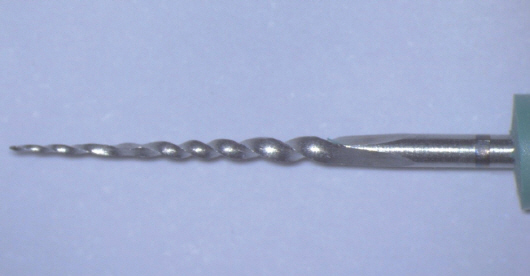J Dent Rehabil Appl Sci.
2019 Mar;35(1):20-26. 10.14368/jdras.2019.35.1.20.
Effect of adaptive movement on durability and working time of twisted file
- Affiliations
-
- 1Department of Conservative Dentistry, College of Dentistry, Gangneung-Wonju National University School of Dentistry, Gangneung, Republic of Korea. mendo7@gwnu.ac.kr
- KMID: 2450922
- DOI: http://doi.org/10.14368/jdras.2019.35.1.20
Abstract
- PURPOSE
Recently TF-adaptive movement is developed in order to increase the durability of TF files. The purpose of this study was to assess the effects of adaptive movement on durability and performance of twisted files.
MATERIALS AND METHODS
Resin blocks simulating artificial J-shape canals were used for this study. In TFC group, TF-adaptive ML-1 (25/.08 size) files were used to prepare the canals under continuous rotation 500 rpm/4.0 Ncm. In TFA group, TF-adaptive ML-1 (25/.08 size) files were used to prepare the canals under adaptive movement. After preparing each artificial canal, TF files were observed under dental microscope for assessing existence of unwinding, distortion, and fracture. If unwinding of flute was observed, the number of artificial canals until unwinding of flute occurs was recorded. Required time until instruments reach working length and distance of unwinded portion of files from D0 were measured. All test results were conducted by Mann-Whitney U test at a 0.05 level of significance.
RESULTS
No NiTi instrument's separation was observed. Number of resin blocks until file unwinding happens and working time was significantly high in TFA group compared to TF group. Distance of distortion from D0 didn't show significant difference between TFA, TF groups.
CONCLUSION
The number of resin blocks prepared until unwinding happens and working time were significantly high in TFA group. The location of unwinding showed no significant difference between 2 groups. Adaptive movement increased the number of canals prepared until unwinding occurs and working time of twisted files.
Keyword
MeSH Terms
Figure
Reference
-
References
1. Cheung GS, Liu CS. A retrospective study of endodontic treatment outcome between nickel-titanium rotary and stainless steel hand filing techniques. J Endod. 2009; 35:938–43. DOI: 10.1016/j.joen.2009.04.016. PMID: 19567311.2. Larsen CM, Watanabe I, Glickman GN, He J. Cyclic fatigue analysis of a new generation of nickel titanium rotary instruments. J Endod. 2009; 35:401–3. DOI: 10.1016/j.joen.2008.12.010. PMID: 19249604.3. Kim HC, Yum J, Hur B, Cheung GS. Cyclic fatigue and fracture characteristics of ground and twisted nickel-titanium rotary files. J Endod. 2010; 36:147–52. DOI: 10.1016/j.joen.2009.09.037. PMID: 20003955.4. Pérez-Higueras JJ, Arias A, de la Macorra JC. Cyclic fatigue resistance of K3, K3XF, and twisted file nickel-titanium files under continuous rotation or reciprocating motion. J Endod. 2013; 39:1585–8. DOI: 10.1016/j.joen.2013.07.020. PMID: 24238452.5. Bouska J, Justman B, Williamson A, DeLong C, Qian F. Resistance to cyclic fatigue failure of a new endodontic rotary file. J Endod. 2012; 38:667–9. DOI: 10.1016/j.joen.2012.01.016. PMID: 22515898.6. Higuera O, Plotino G, Tocci L, Carrillo G, Gambarini G, Jaramillo DE. Cyclic fatigue resistance of 3 different nickel-titanium reciprocating instruments in artificial canals. J Endod. 2015; 41:913–5. DOI: 10.1016/j.joen.2015.01.023. PMID: 25771139.7. Özyürek T. Cyclic Fatigue Resistance of Reciproc, WaveOne, and WaveOne Gold Nickel-Titanium Instruments. J Endod. 2016; 42:1536–9. DOI: 10.1016/j.joen.2016.06.019. PMID: 27520406.8. Pedullà E, Lo Savio F, Boninelli S, Plotino G, Grande NM, La Rosa G, Rapisarda E. Torsional and Cyclic Fatigue Resistance of a New Nickel-Titanium Instrument Manufactured by Electrical Discharge Machining. J Endod. 2016; 42:156–9. DOI: 10.1016/j.joen.2015.10.004. PMID: 26586518.9. Gambarini G, Piasecki L, Di Nardo D, Miccoli G, Di Giorgio G, Carneiro E, Al-Sudani D, Testarelli L. Incidence of Deformation and Fracture of Twisted File Adaptive Instruments after Repeated Clinical Use. J Oral Maxillofac Res. 2016; 7:e5. DOI: 10.5037/jomr.2016.7405. PMID: 28154749. PMCID: PMC5279771.10. Gambarini G, Plotino G, Piasecki L, Al-Sudani D, Testarelli L, Sannino G. Deformations and cyclic fatigue resistance of nickel-titanium instruments inside a sequence. Ann Stomatol (Roma). 2015; 6:6–9. DOI: 10.11138/ads/2015.6.1.006.11. Gambarini G. TF™Adaptive:a novel approach to nickel-titanium instrumentation. X Endodontic Practice. 2014; 7:e2.12. Reddy PJ, Kumar VS, Aravind K, Kumar HT, Vishal M B, Vizaikumar VN, Das R, Vamsilatha K. Canal Shaping with One Shape File and Twisted Files:A Comparative Study. J Clin Diagn Res. 2014; 8:1–3. DOI: 10.7860/JCDR/2014/11126.5333. PMID: 25654059. PMCID: PMC4316365.13. Schäfer E, Diez C, Hoppe W, Tepel J. Roentgeno-graphic investigation of frequency and degree of canal curvatures in human permanent teeth. J Endod. 2002; 28:211–6. DOI: 10.1097/00004770-200203000-00017. PMID: 12017184.14. Braga LC, Magalhães RR, Nakagawa RK, Puente CG, Buono VT, Bahia MG. Physical and mechanical properties of twisted or ground nickel-titanium instruments. Int Endod J. 2013; 46:458–65. DOI: 10.1111/iej.12011. PMID: 23078183.15. Shen Y, Cheun GSP. Methods and models to study nickel-titanium instruments. Endodontic Topics. 2013; 29:18–41. DOI: 10.1111/etp.12046.16. Gambarini G, Giansiracusa Rubini A, Sannino G, Di Giorgio G, Piasecki L, Al-Sudani D, Plotino G, Testarelli L. Cutting efficiency of nickel-titanium rotary and reciprocating instruments after prolonged use. Odontology. 2016; 104:77–81. DOI: 10.1007/s10266-014-0183-0. PMID: 25433447.
- Full Text Links
- Actions
-
Cited
- CITED
-
- Close
- Share
- Similar articles
-
- Influence of glide path size and operating kinetics on time to reach working length and fracture resistance of Twisted File adaptive and Endostar E3 nickel-titanium file systems
- Effect of file size in measuring electronic working length of teeth with open apex
- Effect of adaptive motion on cyclic fatigue resistance of a nickel titanium instrument designed for retreatment
- Study of endodontic working length of Korean posterior teeth
- A comparison of the length between mesio-buccal and mesio-lingual canals of the mandibular molar



